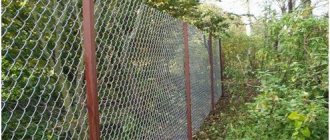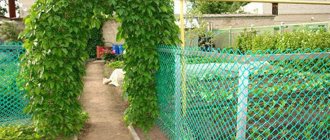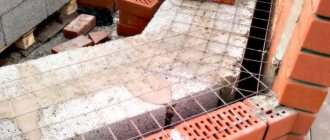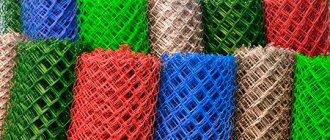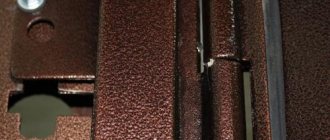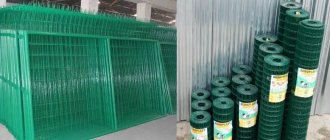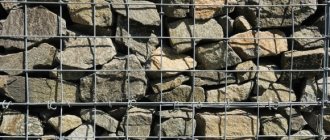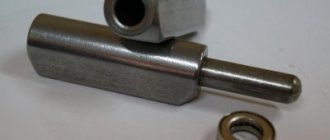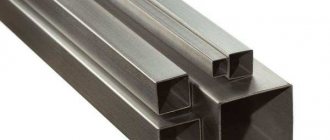Before attaching the chain-link mesh to the profile pipe, the pillars must be prepared. Why do they need to be cleaned of rust, if it appears, painted with a spray or brush. But most importantly, before attaching the chain-link mesh to metal posts, you need to weld hooks to fix the mesh material (considered the best option for tension fencing). If this option is not available, fastening to the corrugated pipe can be done with clamps, staples or wire.
How to attach a mesh metal sheet without welding
Choosing the right grid
The mesh differs in cell sizes, as well as in the material used. The cheapest is considered to be a mesh with large cells, woven from black wire. It is not suitable for a permanent fence, but is suitable for temporary fencing. Black wire corrodes easily, so it will only last three to four years.
Sometimes its service life is extended by painting or treating it with bitumen.
Galvanized wire makes the mesh strong, durable, and more attractive in appearance. This kind of chain-link is more expensive, but it can be used to build permanent fences - light but durable. Nowadays, manufacturers additionally coat galvanization with protective polymers, which give the mesh a different color.
In order to choose correctly and not overpay, you must first decide on the purpose of the mesh. If you need to temporarily fence or demarcate an area, you should not take an expensive chain link; the most ordinary one will do. If you plan to install a permanent fence, be sure to choose high-quality galvanized mesh.
To make the fence decorative, you can purchase colored mesh.
Fine mesh netting is usually purchased for fencing poultry to prevent chickens from crawling into other areas, such as the garden. If the fence is needed for demarcation, a chain-link with large or medium cells is suitable. Everyone chooses the height of the fence separately; The mesh width is from a meter to 1.8 m, the standard length is 10 m.
Preparing the mesh mesh. How to attach a chain-link mesh: many ways to achieve a single goal
22 min.
General issues
Fencing is a mandatory attribute of a personal garden and summer cottage. Some owners choose to build a permanent fence, while others, on the contrary, do not want to shade the plants on the territory, so they prefer to install lightweight structures - mesh ones. This solution has quite a few advantages over solid walls, not the least of which is the strength of a metal wire fence along with ease of installation. You don't need to be a jack of all trades: just have or find the right material, and then learn how to attach the chain-link mesh to ensure its ideal tension. There are even several methods; the owner will only have to choose the one that is more convenient in terms of work, the one that will be as reliable as possible.
Types of chain-link mesh, its characteristics
The very name “grid” does not allow much imagination to run wild. Chain-linking is made by screwing wire spirals into each other. Cells can be strictly rectangular or rhombic, in which the upper and lower angles are equal to 60°. Their size (the accepted value is the distance between the opposite corners of the cell) also varies: it can be 10-100 mm, but for fences the numbers are different - 40-50 mm. Smaller size is synonymous with greater reliability, which means its cost is also the highest.
Such unpretentious material is convenient, even when it comes to transportation: it is transported in rolls that do not take up much space. The range of products is not too large, but everyone will find an option for themselves: both in price and in quality. The chain-link mesh is:
- Simple - non-galvanized, short-lived. After installation, such material needs a protective coating - paint (liquid rubber), otherwise soon - after the first rain or fog - the mesh will rust, and after a few years it will have to be thrown away.
- Galvanized. This chain-link is not afraid of corrosion, so its service life is quite long. Fences with zinc coating look more attractive, but for this beauty, coupled with reliability, you will have to pay a little more.
- Plasticized, coated with an anti-corrosion polymer - polyvinyl chloride with additives. Plastic shells have different colors (green, red, gray, blue, black), which owners can choose at their discretion. This super-protected chain-link is the most reliable product, which is why it has the highest price. However, this drawback does not prevent its popularity from growing.
How to choose support pillars
High-quality installation of a chain-link fence with your own hands implies not only technology, but also a competent choice of load-bearing supports.
- metal;
- wooden;
- reinforced concrete;
- asbestos.
The light weight of the fence allows the use of a metal profile with a cross-section of 60x40 mm, thin pipes and channels. Such supports have a relatively high price, but they look neat and last a long time. Iron fence elements need to be treated with anti-corrosion mixtures and also require painting periodically.
If hollow posts are used, they must be covered with canopies or special covers on top.
Which is better: heated floors or radiators?
Warm floorBatteries
Columns from profile
Wooden posts are not as strong, but are much cheaper. The processing of wooden stakes for mesh is simple: they are cleared of bark, thoroughly sanded, the lower part is coated with bitumen, the rest is painted or primed with an antifungal compound. This allows you to significantly extend the service life of the columns.
Reinforced concrete pillars, like asbestos pipes, are the most convenient supports for such a fence. They are cheaper than metal ones, more durable, do not require processing, and they also do not need to be repainted annually. In any weather conditions, concrete supports are consistently reliable.
How to connect different cells in a chain-link mesh?
If you found many different pieces of mesh in your household and decided to connect all your leftovers, but they are completely different, then it will be easier to connect them using a rod that stretches along the inner surface of different spirals at the junction.
If, when installing a fence, you have to choose from different sized pieces of chain-link mesh, then from an aesthetic point of view we recommend making the same sides of the area. And if this is not possible, then make the connection along the pole.
We are confident that you will succeed. Good luck to you!
When making a chain-link mesh with your own hands, a machine and wire are required. With their help, a spiral is made. The wire should not be curled too much, then the mesh will be smooth and neat. A wire that is too twisted will be difficult to weave into the overall fabric. The mesh will be less distorted and damaged during operation if the machine is lubricated with automobile oil. And better sliding will be facilitated by well-polished and rounded corners and grooves of the machine.
The machine will help you produce chain-link mesh with your own hands without spending a lot of money on it.
Necessary materials and equipment to create the machine:
- sanding paper;
- file;
- paper;
- metal corners;
- angle grinder;
- welding machine;
- rollers;
- bearing race;
- pieces of iron;
- steel plate;
- part of the pipe.
No matter how you position the machine, the main priority is ease of use. You need to guide the wire with one hand and rotate the handle of the machine with the other.
You need to guide the wire with one hand and rotate the handle of the machine with the other.
You need to make sure that the spirals do not get tangled.
The machine has the following devices:
- serving;
- tension;
- lubricating;
- winding (curling).
Making the markings
You need to determine the location of the corner posts by marking them with pegs. Then connect them with a stretched cord, fishing line or rope. If the fence has turns, measure the required distance from the post, drive in a peg and pull the cord again.
This is how the perimeter of the future fence is marked. Next, you need to outline the locations of the remaining supports. To avoid unnecessary sagging, the posts are placed every 2 m, maximum 2.5 m. This means that 2 meters are measured from the corner and a mark is placed, and so on until the end of the fence.
Fencing installation
Installation of the fence is carried out in the following order:
Installation of support pillars
A cord is stretched between the corner pegs, and holes with a depth of at least 70 cm are dug every 2.5 m. Posts are installed in these holes with your own hands, and then the holes are concreted or filled with crushed stone. It is recommended to concrete the metal supports. This way they will stand more stable and thieves will not be able to steal them.
Concrete and wooden pillars can be concreted, but you can fill the holes with crushed stone or construction waste. In this case, the holes must be thoroughly watered and compacted. Since the chain-link does not have significant weight and windage, such supports will fully support the weight of the fence.
Tensioning the mesh
After installing the pillars, the mesh is tensioned. To do this, a roll of mesh is installed near the outermost post, and the chain-link is securely fixed to the support. Next, the roll is unwound with your own hands, and the mesh is attached to each support. It is recommended not to lower the mesh all the way to the ground, but to leave a gap of about 5 cm. Later, this gap can be closed with any solid material. This way you will protect the chain-link from contact with wet soil.
Attaching the mesh to the posts
The method of attaching the chain-link to the supports depends on the material of the supports themselves. The fact is that the chain-link is attached to different materials in different ways.
Metal poles
As a rule, metal supports already have special brackets, hooks or plates, which are fastenings. The mesh is attached to the metal posts using clamps or wire. Moreover, it is advisable to use stainless steel wire. If the mesh is put on hooks, then use a hammer to bend the hooks. You can also attach the mesh to metal posts using plates with holes drilled in them. Threaded pins are threaded into the holes, which must be secured with nuts through the holes in the supports.
Attaching a chain-link mesh to a metal post
Concrete posts
Since concrete supports do not have any fastening, the chain-link is secured to them using large clamps or simply tied. For this purpose, strong steel wire is used.
Wooden supports
The mesh is attached to wooden posts using nails or staples. If they are unavailable, you can use strong wire. Using it you need to secure the chain-link to the support in several places.
How to dig holes correctly
For such a light fence, it is not necessary to dig the posts very deeply. Sometimes they are simply driven in if the soil is dense enough and there is no risk of flooding of the area. This method is justifiable to use temporarily, but for a permanent fence it is better to dig the posts and concrete them. How to properly tension a chain-link mesh video? The easiest way to dig holes is with a garden drill; it is convenient, quick and saves energy.
You won't be able to dig a narrow hole with a shovel; then you'll have to fill it up a lot and compact it. The depth of the holes is approximately 1 m, on loose soil - 1.2 m. How to stretch a chain-link mesh with your own hands? Often, the installation of mesh fences is carried out this way: holes are dug only to half the required depth, after which the supports are driven in.
How to stretch chain-link mesh onto poles
Wooden posts are a budget and affordable building material, but these posts will not last long. It is advisable to install beams only when a temporary fence is being installed.
Before stretching the chain-link mesh onto wooden posts, they should be prepared. The bars are cleaned. Next they are cut to the desired size. Usually they are deepened 30 cm below the freezing point of the ground.
Options for correct chain link fastening
Thus, the length of the beams is at least 2.5 m. The underground part of the beam is treated with mastic. The remaining part of the height of the fence is painted, otherwise the boards will quickly rot. The chain-link mesh is stretched between the posts and attached to the beams with nails.
Pillars made of profile pipes are much preferable; they are stronger and more durable. Usually, to stretch the fabric, choose a square or rectangular profile of 50–70 mm. Metal thickness – at least 1.7 mm. To save money when constructing a fence, pipes are purchased at a scrap metal collection point.
In some cases, you can find water pipes here that have lost their integrity, but are not subject to the corrosion process. They are no longer suitable for water supply, and to stretch the fabric over a fence, their tightness does not matter.
Fastening sketches
Nowadays the market sells poles that are ready for installation of a chain-link fence. The stands themselves are already painted and have hooks installed. These racks will be a little more expensive, but there is no need for related work.
Asbestos-cement or concrete pillars are also often chosen. The chain-link is secured to the fence only with clamps or using a cable. It is inserted into the mesh, weaving the post.
Installation of pillars
To prevent the supports from sagging or warping, a sand cushion is placed at the bottom, on which a little gravel is poured. You can also sprinkle crushed stone or broken bricks.
- level;
- scrap;
- concrete solution;
- spacers
The pillars are lowered and leveled, in addition, they are leveled in height. Crushed stone and earth are poured into the hole and compacted with a crowbar. If the column is hollow inside, it is filled with solution; then they are leveled again, strengthened with spacers and concrete is poured.
Mesh fence diagram
Installation of a tension fence
Installation of a tension fence
Step 1. Attaching the mesh
A roll of chain-link is placed near a corner post, unwinded a little and the cells are put on the hooks. To securely fix the edge of the mesh, you need to take a piece of reinforcement with a cross-section of 8 mm and a length of 1.5 m and thread it into the cells of the first row. After this, the fittings are attached to the pipe and welded. Now, when tensioning the roll, the mesh will not sag. Having secured the end of the mesh, the roll is transferred to the next support, carefully unwinding it.
How to attach the mesh
Having retreated 10-15 cm from the junction of the chain-link with the pipe, a steel rod is again threaded into the cells. This time there is no need to weld it, it will simply help to tension the mesh evenly. When the mesh is put on the hooks, the rod is removed, the roll is unwound another span, the reinforcement is inserted again, and so on until the very end of the fence. To connect two sheets, use wire from the outermost vertical row of one of the rolls.
Tension fencing device
Step 2. Fixing the canvas from sagging
Even a well-stretched canvas sags a little over time, so at the installation stage you need to take care of additional fixation of the chain-link between the posts. You will need 6 mm wire and a welding machine. The wire is threaded into the second or third row of cells horizontally along the entire fence. Where the mesh adjoins the posts, the wire is welded. Then the lower edge of the mesh is strengthened in the same way, and finally the hooks are bent. Now the fence canvas is securely fixed on the supports and will not sag or sag.
How to install a chain-link fence
Step 3. Final stage
Once the fence is installed, the finishing touches need to be completed:
- place plastic plugs on top of the pipes;
- paint the posts;
- Twist the upper tendrils of the chain-link in pairs into 2 turns and bend down.
At this point, the installation of the tension fence is considered completed.
Stages of building a chain-link fence
Video - Connecting a chain-link into one roll
Chain link fastening
The better the preparation, the easier it is to install chain-link fences. The first roll of mesh is placed vertically near the corner post. Using a knitting wire, the edge of the fabric is attached to the support in three places along the height. Unwinding the mesh, the roll is moved to another post and pulled tightly.
Again they fix it with wire and move on. Another way: the roll is unwound completely along the line of the pillars, then with a sharp movement the mesh is lifted vertically and one end is screwed to the support. From the other end of the roll, a section of profile is threaded vertically into the cells - this will help to properly tension the mesh and not damage the shape of the cells.
Attaching the mesh to the stand
The second option requires the presence of an assistant, otherwise the chain-link will get tangled. It is very important to tension the canvas evenly, or some spans will be level, others will sag. You should not attach the mesh close to the ground - you need to leave a distance of 15 cm from the ground. When the canvas is completely secured, a thick wire must be threaded along the top of the mesh to prevent possible sagging.
If you need to connect two pieces of mesh, unscrew the wire spiral and tie both pieces together with it.
Following these recommendations, installing a chain-link fence is easy. Its further operation will not require special care or costs. If necessary, it can be tinted.
How to connect a chain-link mesh together. How to connect a chain-link mesh together in height - video
Considering that the standard length of a chain-link roll is 10 meters, this is clearly not enough to fence even a small area. Therefore, it is necessary to connect the rolls together. Let's consider what options and methods of connection there are.
How to connect a chain-link mesh together
3 ways:
Connecting a chain-link mesh with the same mesh size
Everything is simple here. You need to pull out the last turn in one of the rolls; it will act as a connecting wire, having exactly the same parameters as the wire in the connected rolls. Due to the specifics of production, the wire has different lengths, i.e. turns of different sizes are wound in pairs. Therefore, before you start tying, you need to determine the top and bottom of the connecting wire. Then lay the two sheets on a flat surface and screw the connecting wire between the turns of the connected rolls.
Screwing in a coil of wire to connect the chain-link
You can connect two rolls of chain-link by weight, but this is only possible with help and some skill. Material prepared for the website www.moydomik.net
If you incorrectly determine the top of the connecting wire, then the canvases will not fit together as expected and will have different heights.
Incorrectly connected rolls of chain link - different heights
To avoid this, you need to check how the roll ends. If it is a pair, then you need to unscrew one wire, if it is an unpaired turn, you need to unscrew two wires. One will serve as a connecting one, and the other will be used for the next connection.
How to connect a chain-link mesh -
Connection of mesh netting with cells of different sizes
In this case, the function of the connector is performed by a piece of reinforcement or a long strong wire (in extreme cases, a wooden batten) to which all the turns of the panels being connected are attached.
How to connect two rolls of chain-link with different mesh sizes
Connecting a chain-link mesh along a post
This is the simplest, but not very aesthetic way of connecting. In this case, the mesh sheets are selected in such a way that the connection falls on the support post for the fence, and fastening is done by screwing both mesh sheets directly to the post.
Based on the three existing ways to connect two rolls of chain-link, you can choose the appropriate one, taking into account the situation.
What types of chain-link mesh are there for a fence?
The Ograda-DV company installs turnkey chain-link fences in Khabarovsk. We use three types of mesh:
- Wicker mesh netting. How to properly tension a chain-link mesh video? The round wire is pre-set to a specific profile shape in the form of spirals. Their sequential weaving ensures the formation of a mesh of the desired shape.
- Woven mesh. Cross weaving of horizontal and vertical wires.
- Welded mesh. Made from reinforcing steel by spot welding longitudinal and transverse rods. Divided into:
- Galvanized welded mesh
- Non-galvanized welded mesh
Installation of a chain-link fence in Khabarovsk
Easy installation and speed of construction of a chain-link fence is one of the main advantages of this fence. Like any fence, it basically consists of pillars installed at a distance of 2-3 meters from each other. When installing poles in the ground, one basic requirement must be observed - they must be fixed below the freezing level of the ground. When concreting pillars, sand is poured into a prepared hole dug in the ground, thereby providing a sand cushion.
The pillar is pre-aligned on a vertical and horizontal plane and filled with concrete.
An excellent alternative to concreting is a chain-link fence on screw piles. In this case, the installation of fence posts does not require excavation and concrete work - the support is screwed to the mating part of the pile using a flange connection. You can install the mesh immediately without waiting for the concrete to harden.
Thus, a chain-link fence on poles can be installed in one working day, without the use of special equipment.
As a rule, before installing the chain-link mesh on the poles, the rolls must be connected to each other to achieve the required length. This is done by unscrewing the outer wire of one of the rolls. Then the ends of both rolls are applied to each other and fixed using the same wire, screwing.
A simpler way to connect two rolls of chain-link mesh for a fence is to simply pass a larger wire between the two ends of the mesh. Thus, both rolls are connected into a single span, ensuring the integrity of the structure. Since the height of the rolls is 1.5-2 meters, if necessary, increase the height of the chain-link fence on posts - the bottom is filled with brickwork or decorative rubble stone.
Types of chain link
Types of chain-link
The mesh is made from black and galvanized wire, so the quality of the chain-link varies. Black wire mesh is the cheapest and most short-lived. It becomes covered with rust after the first fog or rain, and after 3-4 years it becomes completely unusable. You can extend the service life of non-galvanized chain-link by using paint or liquid rubber, which should be applied to the mesh before its installation, and then periodically renew the protective layer.
Chainlink made of plain black wire
A mesh made of galvanized wire is not afraid of corrosion, and therefore lasts longer. It costs a little more than black, but does not require any protective treatment at all. Fences made of galvanized chain-link look neat and attractive.
Galvanized mesh
Plasticized chain-link is becoming increasingly popular. This metal mesh is coated with a dense layer of anti-corrosion polymer, due to which it has increased resistance to atmospheric influences. In addition, the polymer is colored, the mesh looks very attractive and aesthetically pleasing. And although such chain-link is quite expensive, the demand for it is constantly growing.
Chainlink mesh with polymer coating
In addition to quality, chain-link mesh differs in mesh size, wire thickness and roll height. Cells can have sizes from 10 to 65 mm, wire diameter 1-5 mm. The roll height is from 0.8 to 2 m, but the most popular is 1.5 m. The standard mesh length in a roll is 10 m; rolls of 20 m are made to order. The smaller the cells, the more expensive the cost of the mesh, because this increases material consumption .
| Type of mesh | Wire diameter, mm | Mesh width, mm | Live mesh cross-section, % | Estimated weight of 1m2 mesh, kg |
| woven mesh with rhombic mesh | 1,20 | 1000 | 55,0 | 4,52 |
| woven mesh with rhombic mesh | 1,20 | 1000 | 61,0 | 33,73 |
| woven mesh with rhombic mesh | 1,20 | 1000 | 69,8 | 2,78 |
| woven mesh with rhombic mesh | 1,40 | 1000 | 65,5 | 3,8 |
| woven mesh with rhombic or square mesh | 1,20 | 1000,1500 | 75,3 (78,9) | 2,20 (1,94) |
| woven mesh with rhombic or square mesh | 1,40 | 1000,1500 | 71,5 (76,2) | 3,00 (2,57) |
| woven mesh with rhombic or square mesh | 1,40 | 1000,1500 | 76,3 (77,0) | 3,24 (2,74) |
| woven mesh with rhombic or square mesh | 1,60 | 1000,1500 | 73,3 (77,0) | 3,24 (2,74) |
| woven mesh with rhombic or square mesh | 1,80 | 1000,1500 | 76,0 (78,9) | 3,25 (2,75) |
| woven mesh with rhombic or square mesh | 1,60 | 1000,1500 | 77,5 (80,9) | 2,57 (2,17) |
| woven mesh for fencing | 1,4 | 1000-2000 | 83,6 | 1,77 |
| woven mesh for fencing | 1,4 | 1000-2000 | 87,0 | 1,33 |
| woven mesh for fencing | 1,6 | 1000-2000 | 85,7 | 1,74 |
| woven mesh for fencing | 1,6 | 1000-2000 | 88,0 | 1,39 |
| woven mesh for fencing | 1,8 | 1000-2000 | 87,0 | 1,76 |
| woven mesh for fencing | 1,8 | 1000-2000 | 89 | 1,46 |
| woven mesh for fencing | 2,0 | 1000-2000 | 87,9 | 1,81 |
| woven mesh for fencing | 1,8 | 1000-2000 | 91 | 1,1 |
| woven mesh for fencing | 2,0 | 1000-2000 | 90,7 | 1,36 |
| woven mesh for fencing | 2,0 | 1000-2000 | 91,7 | 1,23 |
| woven mesh for fencing | 2,5 | 1000-2000 | 90,7 | 1,70 |
| woven mesh for fencing | 3,0 | 1000-2000 | 89 | 2,44 |
| woven mesh for fencing | 2,5 | 1000-2000 | 92 | 1,41 |
| woven mesh for fencing | 3,0 | 1000-2000 | 92 | 1,74 |
| woven mesh for fencing | 2,5 | 1000-2000 | 94 | 1,10 |
| woven mesh for fencing | 3,0 | 1000-2000 | 93 | 1,53 |
Prices for mesh netting
Rabitz
Sectional chain-link fence
In addition to directly tensioning and fixing the chain-link onto the posts, there is another way to install the mesh - on a pre-welded frame. As a rule, this is a metal corner or a profiled pipe. A sectional type chain-link fence looks more beautiful, its strength, due to a more reliable frame, is much higher
compared to a conventional chain-link fence.
In addition to the chain-link itself, a welded mesh is installed in the metal frame.
Since the sections (frames) are made of the same size, when installing a chain-link fence and installing posts, it is necessary to strictly maintain the distance between them. It is also worth considering the elevation difference in the area. Based on these factors, the length of the spans is calculated - in areas with large differences, their width can reach the minimum calculated values.
Regardless of what kind of fence you use (sectional or regular), it is a good idea to cover the fence with anti-corrosion and decorative compounds. Thus, you will extend its service life without neglecting the aesthetic component of your garden plot.
Attaching chain-link mesh to metal posts
Fastening the chain-link mesh to the corrugated pipe is carried out using self-tapping screws and a hook or with a welding machine. In any case, fence supports must be secured carefully. Since they play the role of a frame that allows you to connect all the component nodes with each other.
Drawing for installing a fence
Methods for manufacturing sections
A roll of mesh for the fence is laid out on the ground, measured approximately 2 meters and carefully cut with a grinder, taking into account the selected size. Next, reinforcement rods are installed in the outer rows of links. The metal rods do not need to be connected to each other.
You can also make a frame from a 40x40 mm corner and attach a chain-link to it. Welding will be required to make the frame. This method of fastening will be more expensive.
The photo shows a fence made of profile pipes at the dacha.
Metal fencing made of corrugated pipe
How to attach sections to corrugated pipe posts
The chain-link is laid out on the frame and welding is used to attach the upper part of the reinforcement to the inside of the corner. Then carefully straighten the mesh from below and weld the lower rods. Next, the side parts are installed.
Sketch for installation
The prepared structure is installed vertically to a column made of corrugated pipe and secured to steel plates or corners. You can also attach the fragment with screws by making a hole of the required size.
When installing the next element to the corrugated pipe, you need to make sure that the extreme sections of adjacent frames are in the same plane. Even a difference of a centimeter is noticeable; it will give the fence an untidy appearance. Finally, the mesh is primed and painted. In this way, interconnected sections can be easily installed to any length.
The photo below shows a fence at the dacha.
Sectional fence option
Fastening the chain-link to the pipe using the tension method
To ensure the rigidity of the mesh fence during attachment to the corrugated pipe, a cable with a cross-section of 5–7 mm is stretched from above. This is necessary to resist wind and prevent the chain-link from sagging. This structure can be attached to metal posts and tensioned in any way, but it is better to use special tensioners.
Fastening examples
When installing a fence made of chain-link and corrugated pipe and fastening it with guy wires, the distance between the supports can be made larger, up to 3 m. But it must be taken into account that during the tension process, the load on the metal posts, which are located at the edges, increases. It is necessary to increase their strength in contrast to posts with a regular fence.
Turnkey installation of a chain-link fence in Khabarovsk
Are you thinking of fencing a plot of land quickly and inexpensively? Buying a chain-link fence is the only right decision. The Ograda-DV company specializes in the construction of fences for personal and summer cottages of various types and configurations.
Competent specialists, extensive installation experience and the availability of the necessary equipment allow us to erect a turnkey chain-link fence in one day!
In addition, we have our own production of building materials in Khabarovsk and a store-warehouse of finished products.
Pros of mesh fences
Chain-link mesh is popular in the building materials market and has established itself as an affordable and easy-to-install material.
Fence on a summer cottage
Advantages of metal mesh fencing:
- Every person who is not involved in construction will be able to install this iron fence;
- can be purchased at a relatively low price, and in the Leroy Merlin chain of stores delivery is made free of charge to the site, taking into account the order estimate;
- air circulation throughout the entire territory;
- mesh fences are characterized by good quality and long service life, taking more than 30 years;
- the fence fits perfectly into any landscape design;
- this fence does not shade the garden area;
- if the homeowner has dogs, they can guard the area as effectively as possible so that thieves cannot steal something;
- This is a really reliable fence on which you can install barbed wire if required, this ensures inaccessibility.
Gate in the fence
The product is an excellent material intended for fastening in internal areas of a certain territory, for example, in playgrounds, places where animals are kept and other types of fences. In addition, the list of disadvantages is not as long as the advantages.
Where to buy chain-link in Khabarovsk?
Are you planning to buy a chain-link mesh for installation yourself? And in this matter, the Ograda-DV company will be able to help you. We keep up with the modern spirit of the times - our online store is , on the pages of which you can easily select and buy a chain-link of the desired type and size.
How to treat the surface → Room decoration → How to choose the right paint → Surface treatment technologies → Leveling and finishing the walls → Selecting and applying a primer → Removal from the surface → Stretch ceilings and technologies → Reviews and testimonials

